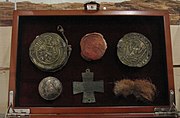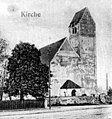St. Quirin (Aubing)
The church of St. Quirin is the original parish church of Aubing , today a district of Munich . The Aubinger parish included not only Aubing itself and neighboring towns, including Pasing , Laim , Untermenzing , Obermenzing and Allach .
The cemetery next to the church was used until 1911.
Building history
Establishment
The Romanesque tower of the Catholic Church of St. Quirin is the oldest preserved building in Aubing. It is dated to the end of the 13th century, supported by dendrochronological studies, which showed that the wood of the old bell house in the tower was cut in the winter of 1283/84. An earlier nave, probably made of wood, was burned down in the Bavarian War in 1422. The Aubingen pastors in the following years tried to rebuild the nave, which was done in the late Gothic style. This church with a rectangular hall and a recessed choir facing to the east still exists today. At that time, however, the nave was even shorter; the west facade ended flush with the west side of the tower. The consecration was carried out in 1489 by the auxiliary bishop Ulrich von Salona , deputy of the Freising Bishop Sixtus von Tannberg .
The year of consecration is known because a collection of consecration utensils came to light during renovation work in the 1960s. These included an imprint of Ulrich's seal, which is interpreted as evidence of his presence, as well as a largely illegible document, which, however, contained a recognizable date, which was initially interpreted as 1480. Therefore, in 1980 the 500-year parish fair was celebrated. However, in later examinations under UV light it turned out that the last digit is not a 0, but a 9. The fact that Ulrich von Salona only became auxiliary bishop in 1484 speaks for the consecration date of 1489. Dendrochronological examinations of the roof beams also showed that they were felled in the winter of 1484/85.
Other consecration utensils found were an Ulrich cross , a glass bottle containing the certificate, a pouch placed around it, a small box that presumably contained chrism , and some bones of unclear meaning.
Changes
The oldest change is likely to be the two-story additions on either side of the choir, a little younger than the nave. The upper floor is each provided with cross vaults, the ribs are similar to those of the church.
The church was painted twice inside, between 1580 and 1594 and again from 1668. Frescoes from the time of the first painting are exposed in the main nave, to the left and right of the side altars, each framing a window. Martin Reiter, pastor in Aubing from December 1632 until his death on September 28, 1669, had the baroque high altar built in St. Quirin in 1668. His grave slab is in the choir of St. Quirin. His stepfather's was found in the tower.
Repairs are documented for 1724 and 1787, and from 1740 the interior of the choir was redesigned in Baroque style . The fresco painting in the vault of the choir also dates from 1740 .
The main entrance was originally on the south side. In the course of an expansion of the surrounding cemetery in 1863, it was moved to the west side and provided with a vestibule (see west view from 1914). The old entrance was walled up and provided with a chapel window. Josef Steinbacher reported in 1914 that “the community” approved 2,600 marks for the construction of an organ and 1,500 marks for a church tower clock in 1879, although it remains unclear whether it was the parish or the Aubing community.
A north aisle based on plans by Michael Kurz was considered in 1913, but was dropped after the First World War in favor of the church in Neuaubing. Due to the strong growth of the community, the church had become too small in the 1930s, despite the construction of the Neuaubingen church. Therefore, in 1936/37, the nave was extended by a fifth yoke to the west according to plans by Kurz .
Ursula shrine
The most important piece of equipment in the church is the shrine of St. Ursula from 1499, which is now housed in the western extension under the gallery . It was once the middle part of an altar , the side wings of which are no longer preserved. Presumably the shrine did not come into the church until the 19th century because it is not listed on old inventory lists.
In the center of the shrine, St. Ursula is depicted, she is slightly larger than her four companions. All five figures have crowns on their heads and martyrs' palms in their hands. On the back of the shrine, which is painted with a representation of the Man of Sorrows and the tools of suffering , characters from the 16th century are carved. Georg Manser von Maisach names an inscription from 1591 with the motto: Everything is possible with God's work .
organ
The organ of the parish church of St. Quirin was built in 1965 by Julius Zwirner from Munich. The electrical slider tray instrument comprises a total of 15 stops on two manuals and a pedal . The disposition is:
|
|
|
|||||||||||||||||||||||||||||||||||||||||||||||||||||||||||||||||||||||||||||||||||||||||||||
- Coupling : II / I, I / P, II / P
- Playing aids : 1 free combination , tutti, piano pedal
Bells
The ringing of St. Quirin consists of five bells. The oldest is from 1516, one from the immediate post-war period (from Euphon). In 1997, for the 700th anniversary of the church tower, three new bells were consecrated and the bell house was thoroughly renovated. All five bells hang on wooden yokes in a wooden chair. With the exception of a shoulder frieze, which is unadorned, a portrait of the respective saint adorns the front.
The bells sound in the notes e 1 - a 1 - h 1 - d 2 - e 2 .
| No. | patron | Casting year | Foundry, casting location |
Weight (kg) |
Diameter (cm) |
Nominal | inscription |
| 1 | St. George | 1949 | Karl Czudnochowsky, Erding | 990 | 124 | e 1 -1 | "VIVOS VOCO, MORTUOS PLANGO, FULGURA FRANGO" |
| 2 | Maria | 1516 | unknown | 560 | 97 | a 1 -1 | "O rex gloriae veni cum pace me resonante pia populi memor esto virgo Maria * 1516 * ora pro nobis" |
| 3 | St. Quirin | 1997 | Karlsruhe bell foundry | 386 | 83 | h 1 | "From the rising of the sun to its setting, the name of the Lord be praised." |
| 4th | St. Ursula | 1997 | Karlsruhe bell foundry | 268 | 72 | d 2 | "The Lord proclaims peace to his people." |
| 5 | St. Sebastian | 1997 | Karlsruhe bell foundry | 184 | 64 | e 2 | "My time is in your hands." |
Clock strikes on bells 3 (1/4) and 1 (1/1). Angelus bell: 3
literature
- Michael Hartig: Catholic parish church St. Quirin - Aubing . Schnell and Steiner, Regensburg 1970, ISBN 978-3-7954-4282-8 (series: Small art guides / churches and monasteries).
- Church leader St. Quirin, Munich-Aubing . Parish Church Foundation St. Quirin (Ed.), Munich 2014
- ???
Web links
- The parish church of St. Quirin and its history on the website of the parish of St. Quirin
Individual evidence
- ↑ Barbara Sajons: Paths to significant sites in Aubing and Neuaubing. From house board to house board . In: Förderverein 1000 years certificate Aubing eV (Hrsg.): 1000 years Aubing. From a medieval village to part of a big city . Friends' Association 1000 Years of Aubing Certificate, Munich 2010, ISBN 978-3-00-030204-6 .
- ↑ Information board in the chapel at the foot of the tower, status 2010
- ↑ a b Poster in the exhibition of the Friends' Association 1000 Years of Aubing e. ..V. on the occasion of the 1000 year celebrations in Aubing, April 2010
- ↑ a b Herbert Liedl: The parish church of St. Quirin and its history . In: Parish of St. Quirin (ed.): Website of the parish of St. Quirin . Munich ( website [accessed May 28, 2010]).
- ^ A b Josef Steinbacher: “Aubing, parish village near Munich. How it came about, how it was and how it is. ”Print the graph. Art Institute Jos. C. Huber , Dießen am Ammersee . Reprint 1983, publisher: Catholic Parish Church Foundation St. Quirin. EOS-Verlag, 8917 St. Ottilien. Pp. 38-42
- ↑ a b c editorial team parish letter St. Quirin: Church leader “St. Quirin Munich - Aubing ” . Publisher Norbert Dinkel, Martinsried / Munich. Without date, laid out in the church in 2010.
- ↑ Josef Feneberg and Barbara Sajons: The village Aubing the Thirty Years War . In: Förderverein 1000 years certificate Aubing eV (Hrsg.): 1000 years Aubing. From a medieval village to part of a big city . Friends' Association 1000 Years of Aubing Certificate, Munich 2010, ISBN 978-3-00-030204-6 .
- ↑ The organ of St. Quirin . Online at www.quirin-aubing.de. Retrieved August 31, 2016.
- ↑ Editorial team Dr. Klaus Bichlmayer, Alois Brem, Veronika Obermayer, Matthias Roth, Rüdiger Zielinski: 700 years of the Aubinger church tower "Bell consecration" . Self-published by the Parish Church Foundation St. Quirin, Munich 1997.
- ^ Walter Niedhammer: The old choir arch cross of St. Quirin - newly attached . In: Parish letter of the parish of St. Quirin . Volume 38, February 2010, p. 10-11 ( PDF ).
Coordinates: 48 ° 9 ′ 25.8 " N , 11 ° 24 ′ 53.8" E














